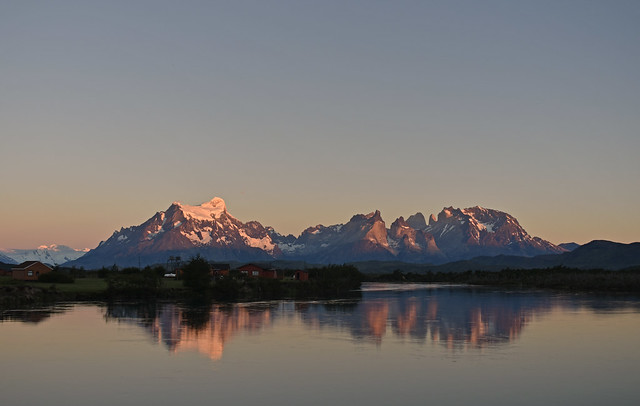Hello
National parks are a place of immense beauty. They are know as tourist attractions and are best recognised by their incredible landscapes. Today we are talking about their effects on the natural world!
National parks are normally created and protected by governments. In most
cases, they have public access, meaning that visitors can walk around in them
and admire them. The
IUCN
defines what is a national park and what isn't. In 2006, over 6 500 areas met
the criteria and are defined as a national park. However, there are many areas
called National Park, that aren't a national park according to IUCN and there
are places that the IUCN defines as a national park but the government
doesn't. So some countries have their own definitions. In the UK and some
other countries, a national park referes to an undeveloped, scenic, tourist
attracting area that has some planning restrictions. This may seem quite
subjective, because there isn't really a scientific definition for scenic. So
the term, national park is not very firm or well defined. Terms such as
"preserve", "reserve" and sometimes just "park" are also used.
The world's oldest national parks include Yellowstone National Park (United
States), Tobago Main Ridge Forest Reserve (Trinidad and Tobago) and Bogd Khan
Uul Mountain (Mongolia). Following the IUCN definition, the smallest national
park is the Isles des Madeleines National Park (0.45 squ.km) and the largest
national park is the Northeast Greenland National Park (972 000 squ. km).
National parks have many benefits for humans. They bring in massive numbers of
tourists, which is highly beneficial for the economy. In the US in 2019, the
national parks brought in 41.7 billion dollars for the US economy. They also
produce hundreds of thousands of jobs and boost the economy on a local level
as well as nationally. Having an accessible green space is also known to have
amzing health benefits especially for people living in crowded cities and
large towns. They are also a research opportunity for scientists and have a
great educational value for pupils and students.
Above all else, national parks are amazing for the environment. They protect
ecosystems, help critically endangered species to recover, protect and improve
air quality, host biodiversity, often store carbon, protect natural
ressources, stabilise soil, reduce flooding, protect coastlines and sometimes
even generate renewable energy. One of the most well known projects, is when
wolves were reintroducted into Yellowstone National Park (United States) in
1995. The wolves tranformed the entire ecosystem and even changed the course
of the rivers. Watch the video
here.
However there is some critism at national parks. This mainly comes from the
fact, that when many national park were created, the indigenous people living
there were forced to move. This has led many people to say that certain
national parks are a symbol of colonialism and should be returned to their
previous owners (the indigenous people). Many governments and organisations
are organising for the indigenous people to be allowed to live in their
ancestrial lands and are often encouraged to continue with their traditions.
Now they are often included in the tourism sector and many indigenous people
in national parks work as guides or performers and help with the conservation
of the land.
We hope you enjoyed this post and found it interesting. If you want us to talk
about one park in more detail then let us know in the comments or send us an
email at contact.greenworld@gmail.com
National parks are a place of immense beauty. They are know as tourist attractions and are best recognised by their incredible landscapes. Today we are talking about their effects on the natural world!

|
| Yosemite National Park, United States |

|
| Fuji-Hakone-Izu National Park, Japan |

|
| Torres del Paine National Park, Chile |

|
| Cairngorms National Park, Scotland |

|
| Yellowstone National Park, United States |

|
| Uluru-Kata Tjuta National Park, Austrailia |
Your Green World Blog Team💚
Sources:
https://en.wikipedia.org/wiki/National_park
https://www.treehugger.com/why-are-national-parks-important-5184042
https://interestingengineering.com/culture/how-do-national-parks-help-the-environment
https://www.filmsforaction.org/watch/how-wolves-change-rivers/
Images:
Yosemite National Park: This image, owned by - Adam Reeder - (on flickr.com), is licensed under CC BY-NC 2.0.
Fuji-Hakone-Izu National Park: This image, owned by SteFou! (on flickr.com), is licensed under CC BY 2.0.
Torres del Paine National Park: This image, owned by Harshil Shah (on flickr.com), is licensed under CC BY 2.0.
Cairngorms National Park: This image, owned by Ben Palmer (on flickr.com), is licensed under CC BY-NC-ND 2.0.
Yellowstone National Park: This image, owned by josephmccowie (on flickr.com), is licensed under CC BY-NC 2.0.
Uluru-Kata Tjuta National Park: This image, owned by scott1346 (on flickr.com), is licensed under CC BY 2.0.
https://en.wikipedia.org/wiki/National_park
https://www.treehugger.com/why-are-national-parks-important-5184042
https://interestingengineering.com/culture/how-do-national-parks-help-the-environment
https://www.filmsforaction.org/watch/how-wolves-change-rivers/
Images:
Yosemite National Park: This image, owned by - Adam Reeder - (on flickr.com), is licensed under CC BY-NC 2.0.
Fuji-Hakone-Izu National Park: This image, owned by SteFou! (on flickr.com), is licensed under CC BY 2.0.
Torres del Paine National Park: This image, owned by Harshil Shah (on flickr.com), is licensed under CC BY 2.0.
Cairngorms National Park: This image, owned by Ben Palmer (on flickr.com), is licensed under CC BY-NC-ND 2.0.
Yellowstone National Park: This image, owned by josephmccowie (on flickr.com), is licensed under CC BY-NC 2.0.
Uluru-Kata Tjuta National Park: This image, owned by scott1346 (on flickr.com), is licensed under CC BY 2.0.

Comments
Post a Comment